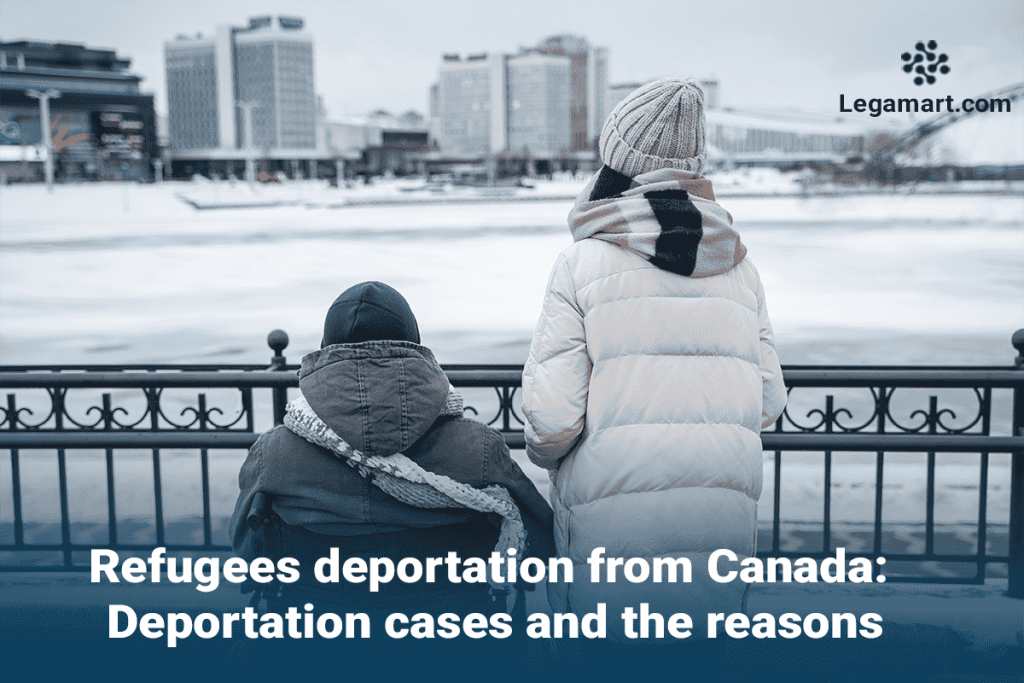Introduction
Last year Canada admitted over 405,000 immigrants. They also accepted nearly 450,000 international students. Another significant international aspect is that the absence of permanent residence pathways in the US has ushered in an increasing number of International employees and refugees moving to Canada to seek permanent residence over the past few years. Canada’s well-regulated and comparatively open immigration system has made it an attractive destination for immigrants and refugees. But with good regulations, Canada has been successful and proactive in the case of refugee deportation from Canada, who are convicted of specific crimes and a threat to the nation. According to CBSA statistics, the Canadian government deported more than 12000 people in 2020.
In this article, we shall explore Canada’s immigration policy in detail and analyze the nuances of refugee deportation from Canada and explore important deportation cases and reasons.
Refugee Deportation in the EU and Canada: Complete Guide 2022 – Legamart
What Is Canada’s Immigration Policy?

Canada is famous for its close openness to asylum seekers. Migrants can argue at any border crossing or airport and at specific government offices inside Canada. In recent years, more than five thousand asylum seekers penetrated the country without approval, which does not come under the purview of criminal conduct once they claim asylum. It can take officials up to two years to decide whether to endow an applicant with protected status or not. Following the granting of asylum status, most asylum seekers are directly eligible to apply for permanent residence. In some special circumstances, unsuccessful asylum seekers may qualify for permanent residency on humanitarian grounds.
Nearly everyone who immigrates to Canada must first apply from overseas, and before admission, they are subjected to comprehensive vetting by Canadian authorities. In most cases, those who make the waiting list for immigration must wait for long periods amounting to months or even years, before being let in. Over the past 25 years, about 5 million immigrants preferred Canada to immigrate. It goes to show the popularity and effectiveness of their immigration policies.
How Does the Canadian Immigration Process Work?
Canada welcomes new permanent residents under multiple categories, out of which 4 are the most integral ones. In the last few years, 58 percent of new permanent residents were accepted through the economic stream, 27 percent through family sponsorship, 14 percent through guarded persons and refugees, and 1 percent on humanitarian grounds.
Economic: Numerous people apply through a point system that provides preference to younger candidates with job offers and increased levels of education, knowledge, and command of language. Every two weeks, the administration requests top-ranking people to apply for permanent residency, a costly and exhaustive process that includes vocabulary testing and biometric screening.
Family: This class of immigrants includes spouses, partners, and children of family members who already exist in Canada. Under this category, legal permanent residents can apply to support their relatives, who must also apply for permanent residency.
Protected persons and refugees: Canada became the world’s top refugee resettler in granting permanent residency to more than twenty-eight thousand displaced people, mainly from Africa and the Middle East, leaving the US behind by a considerable amount. There are two major types of resettled refugees:
- Government-assisted and
- Privately sponsored.
Unfortunately, Refugees cannot apply instantly for resettlement in Canada. Everyone has to experience stringent screening undertaken by Canadian officers and generally retain permanent resident status when they reach.
Humanitarian Grounds: Canada bestows permanent residency to a few people on broadly defined humanitarian and compassionate grounds, such as specific hardships that applicants would encounter if they returned to their original countries. Such individuals must acquire permission to apply. Officials consider diverse factors when judging such cases, such as applicants’ links to Canada and the possibilities they may face if not permitted.
Inadmissibility and Refugees Deportation from Canada

Canada’s geography is bordered by three oceans and the United States, which is itself a magnet for illegal immigrants. For such immigrants, there are three integral types of removal orders for the refugees deportation from Canada and permanent residents issued by Immigration, refugees and citizenship Canada (IRCC) or the Canada border services agency (CBSA). The three types are Departure Orders, Exclusion Orders, and deportation Orders.
In case of a departure order, the individual in question must depart Canada within 30 days after the order takes effect. They should ensure they verify departure with the CBSA at the exit port. If they exit Canada and follow these guidelines, they may return to Canada in the future, provided they meet the entry prerequisites at that duration. If they leave Canada after 30 days or do not verify their departure with the CBSA, their departure order will automatically become a deportation order. To return to Canada in the future, the individual in question must obtain authorization to return to Canada (ARC).
With an exclusion order, the individual cannot return to Canada for one year. If they want to return before the 12 months have expired, they must apply for an ARC. If an exclusion order is issued for misrepresentation, they cannot return to Canada for five years. If the CBSA paid for the expatriation from Canada, that individual must reimburse that cost. With a deportation order, the individual is permanently barred from returning to Canada and cannot return unless they apply for an ARC. If the CBSA paid for the removal from Canada, the individual must reimburse the agency for that cost before they are allowed to return.
What are the Ways to Stop a Deportation Order in Canada?

In the event of refugees deportation from Canada, it is essential to keep updated with the current laws on deportation. Before focusing on how to stop a deportation order, it is critical to know the grounds for deportation, as this will be immensely helpful in not getting a deportation order in the first place.
Presumably, the most prominent cause for deportation from Canada is residing in a country illegally. Whether a person entered originally as an inadmissible individual or penetrated legally on a temporary visa but overstayed, they are subject to deportation sooner or later. Some of the most common grounds for refugee deportation from Canada are inadmissibility are criminal background, health issues, safety issues, economic concerns, or misrepresentation as somebody else. If a refugee enters Canada illegally as an inadmissible person, they will be subject to deportation.
Some individuals enter legally on the grounds of employment and study in Canada and end up overstaying their visas and dwelling in the country illegally. For instance, a student who arrived in Canada on a student visa and remained working in Canada permanently without acquiring a work or extension visa of some sort would be operating illegally in Canada. From this, we can deduce that one of the essential steps toward preventing deportation is to keep track of visas and visa renewals and ensure that the individual is legally residing in Canada.
Now that we know the grounds for refugee deportation from Canada, let us work towards ways to prevent refugees deportation from Canada. There are two principal ways to attempt to avoid deportation. One is to request that CBSA delay the deportation. Another option is to approach the Federal Court and request the judge to stay the removal. When requesting a deferral from CBSA, the individual must be able to give convincing reasons for delaying their deportation. For example, you are pregnant and about to give birth to a child, or you have an existing humanitarian and compassionate grounds application filed on time that is still processing.
Getting Back After Refugee Deportation from Canada

An individual can apply for authorization to return to Canada (ARC). An ARC is an application made to the Canadian Embassy in their specific region that, if authorized, will permit the return to Canada despite the deportation order. But the catch is ARCs are not effortless to get, and one needs compelling justifications to get sanctioned. They can take many months to process. The most promising approach is not to get deported in the first place.
Notable cases on Deportation from Canada
Mugesera v. Canada (Minister of Citizenship and Immigration), [2005] 2 S.C.R. 100, 2005 SCC 40:
This case focused on the immigration process for an individual with a criminal background and its impact on the whole vetting process. Mugesera was into politics, and an arrest warrant was issued against him due to his speeches. He fled the country and applied for permanent residence in Canada. The Canadian authorities decided to deport him on the basis that by delivering his speech, he had incited murder, genocide, and hatred and had committed a crime against humanity. The significant grounds to be considered were Standard of Review, Incitement to Murder, Genocide, Hatred, and Crimes Against Humanity.
Suresh v. Canada (Minister of Citizenship and Immigration), [2002] 1 S.C.R. 3, 2002 SCC 1:
The significance of this case is that it focused on the aspects of administrative law, Judicial review, Standard of review, and Charter of Rights. Suresh was a Convention refugee from Sri Lanka who had applied for landed immigrant status. In 1995, the Canadian government detained him. It commenced deportation proceedings on security grounds, based on the opinion of the Canadian Security Intelligence Service that he was a member and fundraiser of the Liberation Tigers of Tamil Eelam, an organization alleged to be engaged in terrorist activity in Sri Lanka. But there were reports that they suffered torture in Sri Lanka, hence they veered towards criminal activity.
Therefore his deportation from Canada would lead to deportation to torture. But Canadian law and international norms reject deportation to torture. Canadian law views torture as inconsistent with fundamental justice. Therefore, he could have a chance to appeal the deportation order under the principles of fundamental justice.
Frequently Asked Questions
Are Permanent Residents Subject to Deportation from Canada?
Permanent residents may face deportation from Canada if they commit a serious offense before arriving in Canada or if the government believes they are a security risk. Permanent residents can also be deported if they lie on their immigration application, are convicted of a serious offense in Canada, or lose their status as permanent residents. To avoid this, every permanent resident must get citizenship as soon as possible. The Immigration authorities cannot deport a Canadian citizen unless they renounce their citizenship, which can occur in limited circumstances, such as misrepresentation, terrorism, treason, and foreign spying.
Can a Person Enter Canada After Being Deported from the US?
If you have been deported from the United States for any reason, it could have devastating repercussions. Being so close in proximity and sharing a border, Canada and the USA share immigration information. At your point of entry into Canada, the Border Security Agents will see your deportation history in the US. As soon as Canadian authorities find out that you have been deported from the US, they will most likely deny your entry to Canada due to your immigration history.
What is the Difference Between Removal and Deportation from Canada?
There is no difference between removal and deportation. Removal is a newer term for what was deportation proceedings and encompasses inadmissibility and deportability. The legal representation for deportation is “removal,” but many people use these words interchangeably, including attorneys, immigration officers, and immigration judges. A removal order becomes a deportation order when the person decides to leave Canada voluntarily within 30 days of the order.
How Long Do Deportation Orders Last?
If an individual has received any deportation order, he/she is theoretically banned from Canada for life. This means that the individual in question must get an ARC, no matter how much time has passed since leaving the country. For an Exclusion Order, the individual has to leave Canada and stay away for at least twelve months afterward.
Conclusion
There is a significant need to improve the system to avoid refugees deportation from Canada. To resolve this, Canada, which ultimately relies on immigrants to expand its workforce, has significant plans to commence targeting beginners in detailed occupations to guarantee a better match with industries suffering numerous severe labor shortages. This strategy will ensure workers for construction, engineering, food services, and health care organizations.
The current system has resulted in multiple immigrants dying to discover careers that match their skills. Canada strives to bring in more than 1.5 million permanent residents over the next four-five years to achieve its target. Under the new system, immigrants will be categorized based on their age, education, employment experience, and language competencies. The top-caliber prospects will be requested to settle and pursue employment in Canada. Other countries may consider a similar model to ensure their nation’s progress and prevent erratic unemployment.
Uncover the steps and procedures for immigration to different nations, with a focus on Turkey to Norway and US to Portugal, in Legamart’s insightful articles.




